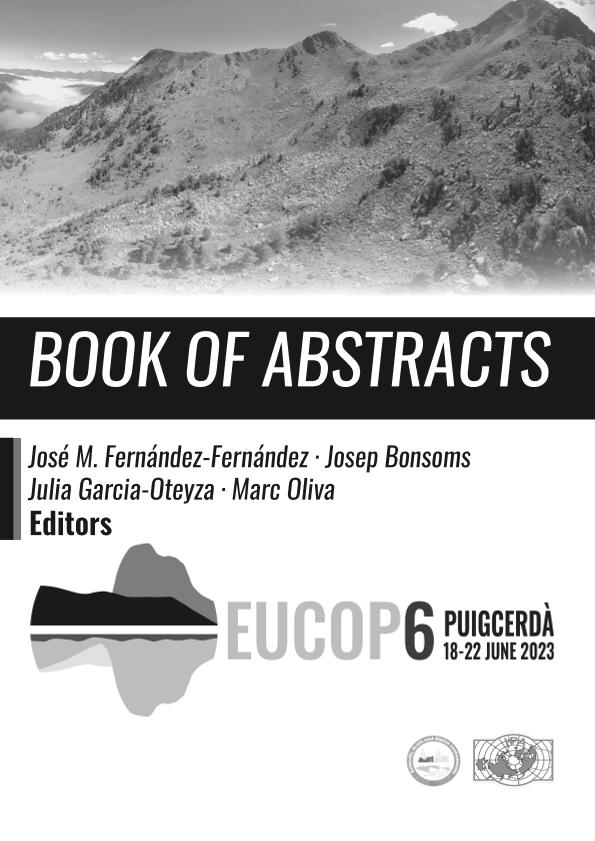Mostrar el registro sencillo del ítem
dc.contributor.author
Brighenti, Stefano
dc.contributor.author
Millar, Constance
dc.contributor.author
Colombo, Nicola
dc.contributor.author
Benech, Andrea
dc.contributor.author
Canturan, Luca
dc.contributor.author
Lencioni, Valeria
dc.contributor.author
Scotti, Alberto
dc.contributor.author
Tolotti, Mónica
dc.contributor.author
Bruno, Maria C.
dc.contributor.author
Janicke, Andrina
dc.contributor.author
Fischer, Andrea
dc.contributor.author
Gschwentner, Andrea
dc.contributor.author
Hayashi, Masaki
dc.contributor.author
Reato, Agustina

dc.contributor.author
Hotaling, Scott
dc.contributor.author
Tronstad, Lusha Marguerite
dc.contributor.author
Finn, Debra
dc.contributor.author
Herbst, David
dc.contributor.author
Larsen, Stefano
dc.contributor.author
Comiti, Francesco
dc.contributor.other
Fernandez Fernandez, José M.
dc.contributor.other
Bonsoms, Josep
dc.contributor.other
García Oteyza, Julia
dc.contributor.other
Oliva, Marc
dc.date.available
2024-02-26T12:33:26Z
dc.date.issued
2023
dc.identifier.citation
Springs from cold rocky landforms: icy seeps in warming mountains; 6Th. European Conference of Permafrost; Puigcerdà; España; 2023; 121-121
dc.identifier.uri
http://hdl.handle.net/11336/228338
dc.description.abstract
The decline of cold environments is among the major effects of climate change. In mountain areas, freshwater habitats have been warming as a result of increasing air temperature, reduction of the snowmelt period, and glacier recession. However, most high-mountain regions contain landforms composed of coarse rocky materials and often containing ice, that are thermally buffered, and sustain cold/cool habitats in otherwise unfavourable climatic conditions. These cold rocky landforms, often originate very cold springs (< 2 °C), termed icy seeps, that might represent climate refugia for coldadapted aquatic organisms. Rock glaciers appear to be the most common source of icy seeps, but other mountain landforms including debris-covered glaciers, morainal deposits, talus slopes, and protalus ramparts can support similarly cold springs. Collectively, icy seeps have been understudied, and little is known about how their thermal regimes vary among types of icy seep and across major mountain ranges. We monitored summer water temperature (mostly 2021/2022) of 152 springs across 14 mountain areas of the Eastern and Western European Alps, Rocky Mountains, Great Basin Mountains, and Patagonian Andes. The monitored springs represented icy seeps from rock glaciers, morainal deposits, talus slopes, protalus ramparts, and debris-covered glaciers, plus reference springs originating from slopes composed of fine materials with diverse origins. Thermal conditions at the same spring types differed among mountain ranges, but icy seeps were consistently colder (by 0.5 – 6.0 °C) than reference springs located within the same catchments, and at comparable elevations. This thermal offset was positively correlated with spring elevation, slope aspect, and average clast size of the landform debris. Our results highlight that major geomorphological drivers are useful for identifying some mountain features as cold rocky landforms for aquatic habitats. Hydroecological research on these environments is needed to address management strategies for climate change adaptation.
dc.format
application/pdf
dc.language.iso
eng
dc.publisher
Universidad de Barcelona

dc.rights
info:eu-repo/semantics/openAccess
dc.rights.uri
https://creativecommons.org/licenses/by-nc-sa/2.5/ar/
dc.subject
Cold environments
dc.subject
Climate change
dc.subject
Aquatic habitats
dc.subject.classification
Oceanografía, Hidrología, Recursos Hídricos

dc.subject.classification
Ciencias de la Tierra y relacionadas con el Medio Ambiente

dc.subject.classification
CIENCIAS NATURALES Y EXACTAS

dc.title
Springs from cold rocky landforms: icy seeps in warming mountains
dc.type
info:eu-repo/semantics/publishedVersion
dc.type
info:eu-repo/semantics/conferenceObject
dc.type
info:ar-repo/semantics/documento de conferencia
dc.date.updated
2024-01-30T12:07:17Z
dc.journal.pagination
121-121
dc.journal.pais
España

dc.journal.ciudad
Barcelona
dc.description.fil
Fil: Brighenti, Stefano. University of Bozen; Italia
dc.description.fil
Fil: Millar, Constance. United States Department of Agriculture; Estados Unidos
dc.description.fil
Fil: Colombo, Nicola. University of Turin; Italia
dc.description.fil
Fil: Benech, Andrea. University of Turin; Italia
dc.description.fil
Fil: Canturan, Luca. Università di Padova; Italia
dc.description.fil
Fil: Lencioni, Valeria. Museo delle Scienze; Italia
dc.description.fil
Fil: Scotti, Alberto. APEM Ltd.; Reino Unido
dc.description.fil
Fil: Tolotti, Mónica. Instituto Agrario San Michele all'Adige Fondazione Edmund Mach; Italia
dc.description.fil
Fil: Bruno, Maria C.. Instituto Agrario San Michele all'Adige Fondazione Edmund Mach; Italia
dc.description.fil
Fil: Janicke, Andrina. Austrian Academy Of Sciences;
dc.description.fil
Fil: Fischer, Andrea. Austrian Academy Of Sciences;
dc.description.fil
Fil: Gschwentner, Andrea. Austrian Academy Of Sciences;
dc.description.fil
Fil: Hayashi, Masaki. University of Calgary; Canadá
dc.description.fil
Fil: Reato, Agustina. Consejo Nacional de Investigaciones Científicas y Técnicas. Centro Científico Tecnológico Conicet - Patagonia Norte. Centro de Investigación Esquel de Montaña y Estepa Patagónica. Universidad Nacional de la Patagonia "San Juan Bosco". Centro de Investigación Esquel de Montaña y Estepa Patagónica; Argentina
dc.description.fil
Fil: Hotaling, Scott. State University of Utah; Estados Unidos
dc.description.fil
Fil: Tronstad, Lusha Marguerite. University of Wyoming; Estados Unidos
dc.description.fil
Fil: Finn, Debra. University of Missouri; Estados Unidos
dc.description.fil
Fil: Herbst, David. University of California; Estados Unidos
dc.description.fil
Fil: Larsen, Stefano. Instituto Agrario San Michele all'Adige Fondazione Edmund Mach; Italia
dc.description.fil
Fil: Comiti, Francesco. University of Bozen; Italia
dc.relation.alternativeid
info:eu-repo/semantics/altIdentifier/url/https://www.permafrost.org/event/eucop6/
dc.relation.alternativeid
info:eu-repo/semantics/altIdentifier/url/https://www.permafrost.org/newsitem/eucop6-book-of-abstracts-available-for-download/
dc.relation.alternativeid
info:eu-repo/semantics/altIdentifier/doi/http://dx.doi.org/10.52381/EUCOP6.abstracts.1
dc.conicet.rol
Autor

dc.conicet.rol
Autor

dc.conicet.rol
Autor

dc.conicet.rol
Autor

dc.conicet.rol
Autor

dc.conicet.rol
Autor

dc.conicet.rol
Autor

dc.conicet.rol
Autor

dc.conicet.rol
Autor

dc.conicet.rol
Autor

dc.conicet.rol
Autor

dc.conicet.rol
Autor

dc.conicet.rol
Autor

dc.conicet.rol
Autor

dc.conicet.rol
Autor

dc.conicet.rol
Autor

dc.conicet.rol
Autor

dc.conicet.rol
Autor

dc.conicet.rol
Autor

dc.coverage
Internacional
dc.type.subtype
Congreso
dc.description.nombreEvento
6Th. European Conference of Permafrost
dc.date.evento
2023-06-18
dc.description.ciudadEvento
Puigcerdà
dc.description.paisEvento
España

dc.type.publicacion
Book
dc.description.institucionOrganizadora
Universidad de Barcelona. Departamento de Geografía
dc.source.libro
Books of Abstracts of the 6Th. European Conference of Permafrost
dc.date.eventoHasta
2023-06-22
dc.type
Congreso
Archivos asociados
